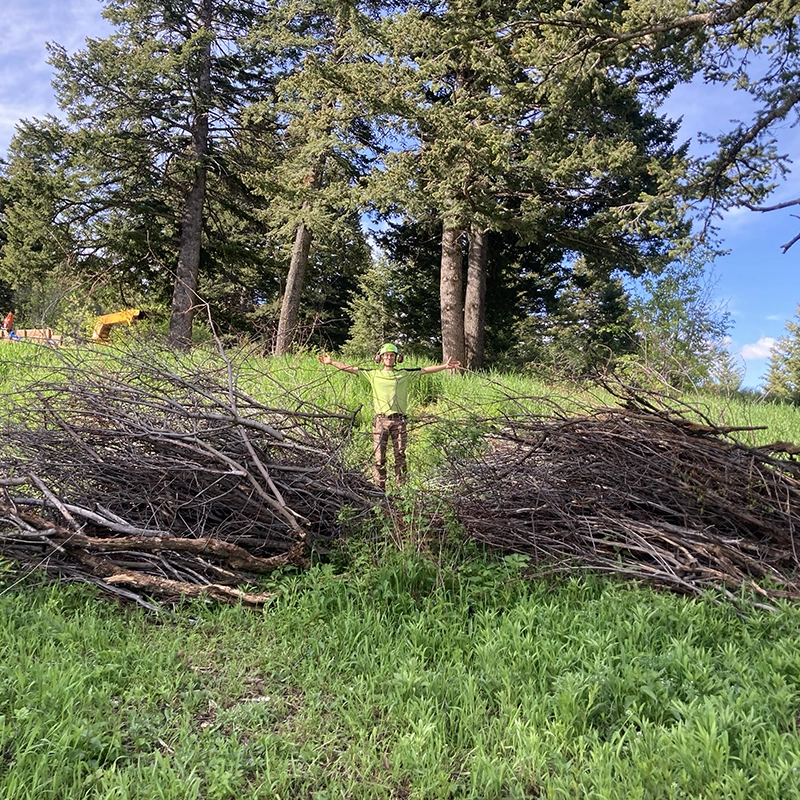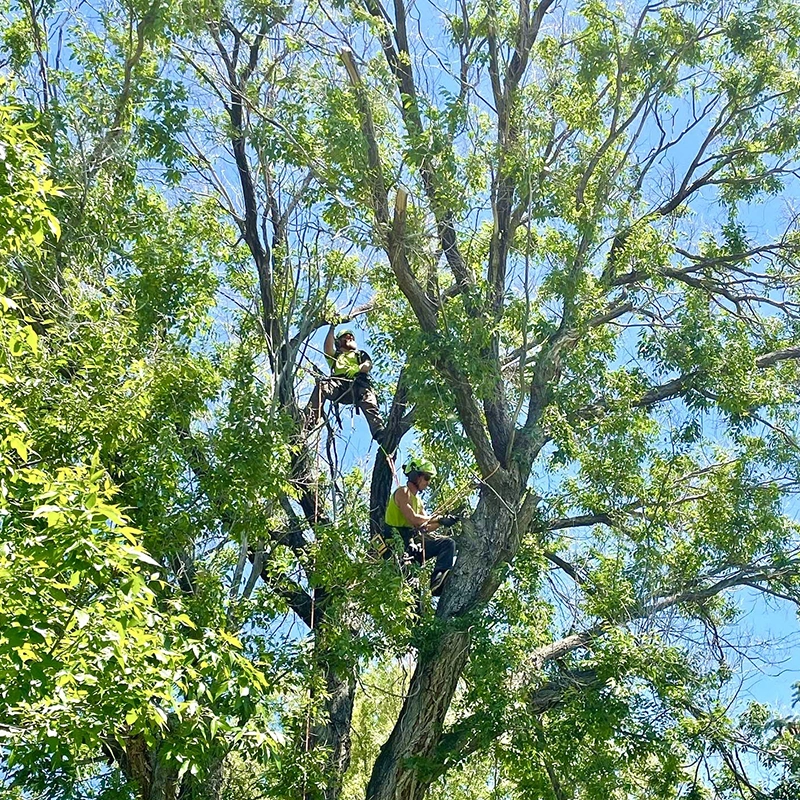
AboutTree Pruning
Tree Pruning Service In Bozeman, MT
Tree Pruning is the selective removal of limbs and branches to promote healthy trees and growth vigor, reduce potential hazards, and maintain proper clearance.
Proper Tree Pruning is defined by having clear goals and adhering to best practices developed for optimum tree growth and safety, while promoting the natural form of the tree, as much as possible.
Why Tree Pruning Matters
Proper tree pruning is essential for healthy trees in residential settings.
The removal of dead, diseased, damaged, or declining limbs improves air flow and sunlight penetration into the canopy, increases growth vigor, reduces potential hazards to the property, and improves the overall health and aesthetics of the tree.
Tree pruning is also necessary to help trees grow within their space limitations, and keep them clear of structures, roadways, walkways, utilities, parking areas, and even adjacent trees and plants.
Tree pruning can also be done in certain settings to promote or stimulate flower and fruit production, such as in an orchard.
TypesOf Tree Pruning
Crown Cleaning: “The removal of dead, dying, diseased, crowded, weakly attached, low-vigor branches, and watersprouts from a tree’s crown. Dead-wooding is a crown-cleaning practice and commonly includes the removal of dead, dying and low-vigor branches.”
Crown Thinning: “Includes crown cleaning and the selective thinning of branches to increase light penetration and air movement through the crown.”
Crown Reduction: “(Crown Shaping) reduces the height and/or spread of a tree, because all too often, it was a poor selection for the site or its landscape use has changed.” Although this practice can reduce a tree’s height or width, it differs from ‘Trimming’ in that cuts are made at specific branch nodes, where proper wound sealing can occur, and adhering to best practices guidelines. ‘Trimming’ often involves making indiscriminate cuts between branch/limb nodes, resulting in excessive sprouting and decay, both of which put stress on a tree.
Crown Raising: “Removes the lower branches of a tree in order to provide clearance for buildings, vehicles, pedestrians, vistas, etc.”
Crown Restoration: “Is more than a tree maintenance operation. It is the improvement of the structure, form and appearance of trees whose branches have been severely headed, vandalized, or storm damaged.” This can often be an option for improving canopy structure on old, mature trees that were ‘topped’ in the past.

Ask Us About Tree Pruning
Frequently AskedQuestions
Do I Really Need a Professional to Prune My Trees?
Every tree is unique in its structure, location, resource availability, environmental exposure, and the issues that affect them. The ISA Certified Arborists at Rootbound maintain an extensive knowledge base to help recognize these factors and make the best recommendations and pruning decisions for your trees.
Pruning trees can also pose a serious risk of injury or property damage, especially if the tree is close to power lines. ISA Certified Arborists are safety professionals and regularly train to understand and work around these hazards. Always contact a professional if your tree is close to electricity.
Hiring a professional ISA Certified Arborist to prune your trees also allows for a closer inspection of the canopy, and the potential early identification of insect or disease issues. Addressing pest problems and introducing tree disease treatment quickly is crucial for success. The early indicators are often subtle.
Improper pruning, or indiscriminate removal of material, can quickly lead to irreversible damage on a tree, which is why it’s always a good idea to contact an experienced ISA Certified Arborist to assess your tree(s) and help outline treatment plans that work with your goals.
When is the best time to prune trees in Bozeman, Montana?
Tree Pruning occurs at all times of the year in the Gallatin Valley and Southwest Montana, depending on the tree species and goals for the work.
Some tree species that are susceptible to disease should only be pruned during the dormant season (Winter), while other species may have a less specific pruning window.
Call today to learn more about the best pruning schedule for your trees.
How often should I have my trees pruned?
Tree Pruning should address a specific need or goal, and this determines the pruning frequency. Younger trees may need more regular tree maintenance to establish optimum structure as they grow and adapt to their locations.
Mature trees generally need far less pruning, often with more targeted goals like removing individual large, dead limbs, or diseased sections of material. An experienced, ISA Certified Arborist can help determine when a tree should be pruned, and how much material can be safely removed without damaging the tree.
We recommend that mature trees be assessed for canopy damage by a qualified ISA Certified Arborist after heavy wind, snow, or ice storm events. Early identification of storm damage or weakened material can be critical for not only safety of the property, but also preserving the tree(s).
Will pruning hurt my tree?
Trees naturally ‘self-prune’ by closing off resources to certain limbs as they become less efficient and less valuable for energy production. ISA Certified Arborists can expedite this natural process through best practices, redirecting energy and resources into the best parts of the tree(s).
When pruned improperly or without discretion, however, a tree can quickly become irreversibly damaged. ‘Topping’ is an example of a common practice that deforms and weakens a tree, not only increasing potential hazards in many cases, but also condemning the tree to eventual (sometimes quick) decline.
Contact Rootbound Arborists today to learn about proper pruning options and comprehensive tree care services for your trees.
What’s the difference between pruning and trimming?
Although often interchanged in conversation, these two practices differ in their purpose and goals.
Pruning focuses on improving tree health assessments and canopy structure through selective removal of specific limbs and branches. There are several standardized types of pruning, as outlined on the ISA website, including Crown Cleaning, Crown Thinning, Crown Reduction, Crown Raising, and Crown Restoration as the primary prescriptions.
Trimming focuses on maintaining a desired canopy size or shape by removing sections of outer branches, often in a more indiscriminate manner. Trimming is most often seen in Utility Right-of-Ways and is often done to appease a human-related conflict, rather than for the health care of the tree.
Can I prune trees near power lines myself?
No, we do not recommend working on any tree within falling distance of a power line or utility.
Trees are excellent conductors of electricity, and any work done on trees in close proximity to a utility should be done by a professional.
Depending on the proximity to power lines, even ISA Certified Arborists are often required (by law) to call in a Certified Utility Arborist (contracted by Northwestern Energy) to make the tree safe enough to perform our work.
How much does tree pruning cost?
The cost of Tree Pruning depends on many factors, including tree size, canopy structure, location, species, quantity, and condition.
At Rootbound Arborists, we offer a wide range of services and innovative solutions to make the pruning process as efficient as possible.
Contact us today for an initial consultation and FREE assessment, and see how our expert tree care can help your trees thrive!
Why ChooseRootbound Arborists
Rootbound Arborists is operated by professional, local arborists with over 15 years of experience in the Arboriculture Industry, and a decade of experience operating in the Bozeman area. We value safety, education, customer service, and integrity above all else, and our recommendations are based on up-to-date science and industry best practices.
In addition to our ISA Arborist Certifications, we also maintain several other professional credentials including the Tree Risk Assessment Qualification (TRAQ), Aerial Rescue Training, and Electrical Hazards Training (EHT). These credentials represent a commitment to the high quality standards of the tree care industry, and provide a framework for informed decision-making when it comes to managing your trees.
Company culture is vital at Rootbound Arborists, and our crew members are unrivalled in their positive, kind communication and strong work ethic. We aim to be approachable and informative, whether regarding project details or just a quick tree-related question.
